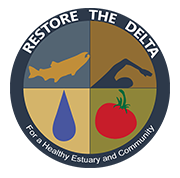Does the State Water Project’s largest contractor have enough customers actually willing to pay for the conveyance being contemplated? With that question in mind, let us turn to our report on the California Water Commission meeting on Wednesday afternoon. At the Water Commission, DWR is urging Commissioners to act under the assumption that new conveyance will be approved and funded.
The meeting began with supervising land agent Alan Davis apologizing to Delta landowners for the recent unprofessional behavior of agents trying to serve them with court papers. (See our last two newsletters.)
We will spare you the confusing discussions of temporary versus permanent easements and the various legal wranglings that have brought DWR to the point of having to use eminent domain to conduct their geotechnical investigations. (We’ve covered those in past newsletters.) It’s clear, though, that some members of the commission are not going to be comfortable with issuing a resolution of necessity for leaving a bore hole filled with grout.
Commissioner Delfino raised the issue of the timeline for BDCP environmental documents, which are supposed to be completed next May. The test borings won’t be done by then, so it is hard to argue that DWR needs the borings for environmental background. And remember that Jerry Meral told the Oversight Committee in the morning that they don’t need the drilling data to complete the Environmental Impact Report (EIR).
But now DWR is saying that it needs the geotechnical data to file for engineering permits required by the Corps of Engineers. DWR Director Mark Cowin was in the audience, and he got up and affirmed the need to do borings to collect engineering data.
But the Corps won’t issue permits anyway unless 30% of the design is completed. And remember, they don’t have a project yet. They need the borings to design the project.
Still with us? It gets better.
The commission isn’t supposed to move down the road to eminent domain unless a project is funded. There was a lot of discussion about whether DWR has 100% funding from the Water Contractors for planning, which covers these geotechnical investigations. Apparently they do. But an amendment to the Water Contractors’ MOA (see article above) specifically excludes engineering studies from the funding agreement. There are “milestones,” and the Water Contractors will only CONSIDER funding as those successive milestones are met.
DWR has been starting every meeting with a review of eminent domain process and resolutions of necessity, including the four findings required. These include showing that the taking is necessary (hard to do when you don’t have a defined project) and that it provides the greatest public benefit with the least private harm.
Of the parcels that were originally going to be considered for resolutions of necessity, most had been removed, as DWR met with some success in trying to negotiate for what it wanted. Of the small number of parcels remaining, DWR began with one owned by Islands Inc. And right away, it became clear that the big issue in this and other cases was whether DWR had provided or could provide an adequate legal description of the area it wanted to investigate.
The commission is not supposed to issue a resolution of necessity without showing that the proposed taking would do the greatest public good while causing the least private injury. They decided that for the parcels before them, they didn’t have enough information to make that determination. So they voted to delay the decisions until November, while requiring DWR to provide better maps and descriptions of exactly what it wanted.
Only Commissioner Kelley disagreed, on the argument that he’s never seen any resolution of necessity actually go before a judge, but it did focus negotiations. But as Commissioner Cogdill noted, the Commission needs to do everything as cleanly as possible, because anything they do will be challenged.

